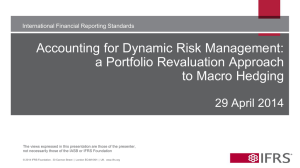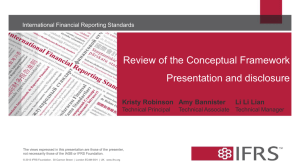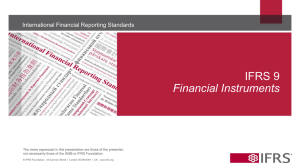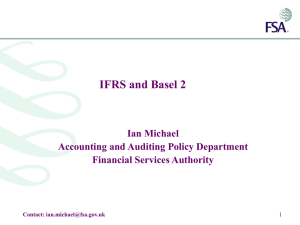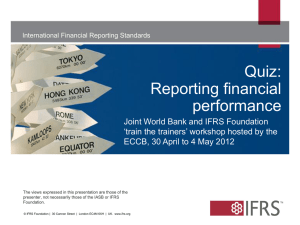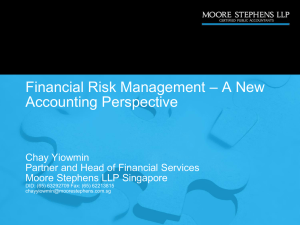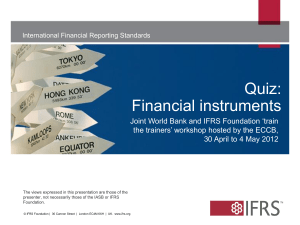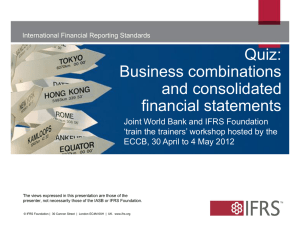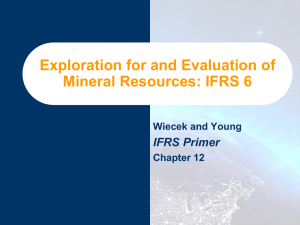Dynamic Risk Management
advertisement
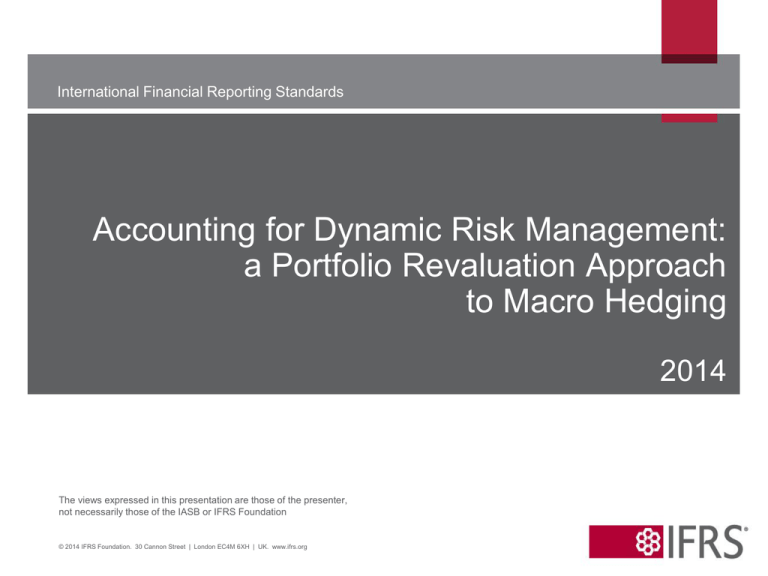
International Financial Reporting Standards Accounting for Dynamic Risk Management: a Portfolio Revaluation Approach to Macro Hedging 2014 The views expressed in this presentation are those of the presenter, not necessarily those of the IASB or IFRS Foundation © 2014 IFRS Foundation. 30 Cannon Street | London EC4M 6XH | UK. www.ifrs.org At a glance 2 • The IASB is exploring an accounting approach to better reflect dynamic risk management (DRM) activities in entities’ financial statements. • The Discussion Paper (DP) uses dynamic interest rate risk management by banks for illustrative purposes. However, the approach considered in the DP is intended to be applicable to other risks (for example, commodity price risk and FX risk). © IFRS Foundation. 30 Cannon Street | London EC4M 6XH | UK. www.ifrs.org Dynamic Risk Management (DRM) 3 • DRM is a continuous process. • Major characteristics of DRM include: dynamic DRM is undertaken for open portfolio(s), to which new exposures are frequently added and in which existing exposures mature. As the risk profile of the open portfolio(s) changes, DRM is updated frequently in reaction to the changed net risk position. © IFRS Foundation. 30 Cannon Street | London EC4M 6XH | UK. www.ifrs.org Challenges under IAS39/IFRS9 hedge accounting 4 • Current hedge accounting requirements are often difficult to apply to DRM because: One-to-one linkage between what is being hedged and the hedging derivative; Can only indirectly accommodate DRM on a net basis through gross designation; Can only accommodate open portfolios by treating them as a series of closed portfolios with short lives; Allows for a degree of behaviouralisation of exposures but this is limited. © IFRS Foundation. 30 Cannon Street | London EC4M 6XH | UK. www.ifrs.org Dynamic interest rate risk management in banks 5 The purpose of dynamic RM is usually to manage Net Interest Income Dynamic Risk Management (DRM) 6 • DRM is a continuous process. It is undertaken for open portfolio(s), to which new exposures are frequently added and in which existing exposures mature. As the risk profile of the open portfolio(s) changes, DRM is updated frequently in reaction to the changed net risk position. • Current hedge accounting requirements are often difficult to apply to DRM. Question 1—Assessing the need for an approach Do you think there is a need for a specific accounting approach to represent DRM in entities’ financial statements? Why or why not? © IFRS Foundation. 30 Cannon Street | London EC4M 6XH | UK. www.ifrs.org The Portfolio Revaluation Approach (PRA) 7 • Exposures within open portfolios are revalued with respect to the managed risk (for example, interest rate risk). • Not a full fair value model. © IFRS Foundation. 30 Cannon Street | London EC4M 6XH | UK. www.ifrs.org The PRA—continued • The net effect between the revaluation adjustment of the managed exposures and the fair value changes of the risk management instruments (for example, interest rate swaps) is reflected in profit or loss. © IFRS Foundation. 30 Cannon Street | London EC4M 6XH | UK. www.ifrs.org 8 Expected improvements with the PRA 9 enhances information about DRM; reduces operational complexities such as tracking and amortisations; captures the dynamic nature of risk management on a net basis; considers behavioural factors; considers different types of risks managed in open portfolios. © IFRS Foundation. 30 Cannon Street | London EC4M 6XH | UK. www.ifrs.org Behaviouralisation (‘core’ demand deposits) 10 amount outstanding Core demand deposits time • At a portfolio level, the ‘sticky’ nature of demand deposits leads to the identification of a stable portion in the amount outstanding. • These core demand deposits are deemed to be fixed rate deposits with longer maturities for risk management purposes (behaviouralisation). Behaviouralisation and revaluation of the managed exposures 11 Question 2—Behaviouralisation For the purposes of applying the PRA, should the cash flows be based on a behaviouralised rather than on a contractual basis, when the risk is managed on a behaviouralised basis? Question 3—Core demand deposits Do you think that core demand should be included in the managed portfolio on a behaviouralised basis when applying the PRA if that is how an entity would consider them for DRM purposes? Question 4—Revaluation of the managed exposures Do you think that the revaluation calculations provide a faithful representation of DRM? Why or why not? © IFRS Foundation. 30 Cannon Street | London EC4M 6XH | UK. www.ifrs.org Hedge accounting and the managed portfolios in DRM © IFRS Foundation. 30 Cannon Street | London EC4M 6XH | UK. www.ifrs.org 12 Pipeline transactions and equity model book (EMB) 13 Question 5—Pipeline transactions Do you think that pipeline transactions should be included in the PRA if they are considered by an entity as part of its DRM? Why or why not? Question 6—EMB Do you think that EMB should be included in the PRA if it is considered by an entity as part of its DRM? Why or why not? © IFRS Foundation. 30 Cannon Street | London EC4M 6XH | UK. www.ifrs.org Transfer pricing—Overview 14 Business and Risk Management Structure Division of responsibilities between Business Unit (BU) and ALM (Asset Liability Management): BU: Focus on customer margin ALM: Interest rate margin management possibly dynamically Made operational through Transfer Pricing BUs raise funds from the ALM for their business activities through transfer pricing (TP) transactions. ALM aggregates the risk centrally for risk management using such TP transactions. © IFRS Foundation. 30 Cannon Street | London EC4M 6XH | UK. www.ifrs.org Identification of the managed risk in the PRA 15 Two important features of the PRA in identifying managed risk: To capture dynamic interest rate RM based on funding index at the ALM Revaluation with respect to ‘funding index’ To provide operational feasibility Transfer Pricing (TP) transactions as a practical expedient © IFRS Foundation. 30 Cannon Street | London EC4M 6XH | UK. www.ifrs.org Dynamic interest rate RM with respect to funding index using TP transactions Business unit makes a fixed interest rate customer loan at 7.1% 3.1% margin earned overall by bank Customerspecific margin 3% ALM funds customer loan at internal fixed interest rate of 4.5% (the transfer rate) 2.6% margin earned by business unit Internal funding spread 0.5% 0.5% margin earned by ALM External funding spread 0.2% 7.1% customer interest rate External pricing decision 16 Market pricing index (for example, base rates) 4.1% Internal pricing decision © IFRS Foundation. 30 Cannon Street | London EC4M 6XH | UK. www.ifrs.org Market funding index (for example, 3-month LIBOR curve) 3.8% 4.5% transfer rate PRA with respect to funding index (1) 17 Suppose a bank has external fixed interest rate loans with a 7.1% contractual interest rate. The BU raises funds from the ALM at 4.5%. This means 2.6% is a customer margin at the BU. The ALM raises funds that are necessary for the BU based on funding index, for instance the 3-month LIBOR curve, from BUs or through the market. Through this process, the ALM manages NII. The basic idea of the PRA is: use CFs that the BU funded from the ALM (4.5% in the example above) as a numerator; and revalue the CFs with respect to the funding index. © IFRS Foundation. 30 Cannon Street | London EC4M 6XH | UK. www.ifrs.org PRA with respect to funding index (2) At Day 1: 4.5% funding transactions are identified as CFs (numerator). The above CFs are discounted at 4.5%. No Day 1 profit or loss. Revaluations in subsequent periods Suppose funding index increases to 5%. Then 4.5% CFs are discounted by a 5% discount rate. Consequently, revaluation adjustment (loss in the above example) is recognised. © IFRS Foundation. 30 Cannon Street | London EC4M 6XH | UK. www.ifrs.org 18 Challenges 19 IFRS 9 hedge accounting requires that any hedged risk component is ‘separately identifiable and reliably measureable’. -- If PRA is applied with respect to funding index, it is likely some eligibility criteria for the identification of the managed risks would need to be considered. It is not always possible to identify a ‘known’ funding source for particular exposures. -- Banks may use more than one funding indexes, say 1‐month LIBOR curve and 3-month LIBOR curve. -- Banks do not necessarily match up particular assets as being funded by particular liabilities. © IFRS Foundation. 30 Cannon Street | London EC4M 6XH | UK. www.ifrs.org Transfer pricing transactions 20 • The DP’s preliminary views are that transfer pricing transactions can be considered for the purpose of identifying the level of the managed risk (numerator of the revaluation calculation) and the revaluation of the latter (denominator of the revaluation calculation). • Transfer pricing accommodates behaviouralisation (eg prepayable mortgages and core demand deposits). Accordingly, revaluing the exposures using transfer pricing would incorporate the behaviouralised risk profile embedded in the exposures. • For these reasons, the DP presents the use of transfer pricing transactions as providing operational feasibility to the PRA. Question 7—Transfer pricing transactions Do you think that transfer pricing transactions would provide a good representation of the managed risk in the managed portfolio for the purposes of applying the PRA? To what extent do you think that risk transferred to ALM via transfer pricing is representative of the risk that exists in the managed portfolio? Scope of the application of the PRA 21 • The scope has significant implications for the information provided to users of financial statements and on how operationally feasible the application of the PRA will be for an entity. • The DP considers two scope alternatives: – Focus on dynamic risk management – Focus on risk mitigation (sub-portfolio approach, proportional approach) Scope of the application of the PRA—continued 22 Risk positions Outside of DRM Within DRM Portfolio Portfolio Portfolio Portfolio Portfolio Portfolio Portfolio Portfolio Portfolio Portfolio Portfolio Portfolio © IFRS Foundation. 30 Cannon Street | London EC4M 6XH | UK. www.ifrs.org Focus on DRM Focus on risk mitigation (sub-portfolio approach) Focus on risk mitigation (proportional approach) Scope of the application of the PRA 23 • The scope has significant implications for the information provided to users of financial statements and on how operationally feasible the application of the PRA will be for an entity. • The DP considers two scope alternatives: – Focus on dynamic risk management – Focus on risk mitigation (sub-portfolio approach, proportional approach) Question 8—Scope of the application of the PRA Do you think that the PRA should be applied to all managed portfolios included in an entity’s DRM or should it be restricted to circumstances in which an entity has undertaken risk mitigation through hedging? Why or why not? If you do not agree with either of these alternatives, what do you suggest, and why? Presentation Statement of financial position • Line-by-line gross up • Separate lines for aggregate adjustments to assets and liabilities • Single net line item Statement of comprehensive income • Actual net interest income presentation • Stable net interest income presentation © IFRS Foundation. 30 Cannon Street | London EC4M 6XH | UK. www.ifrs.org 24 Statement of comprehensive income—Actual NII presentation IFRS 9 25 PRA—Actual NII presentation Interest revenue Interest revenue Interest expense Interest expense Net interest income from derivatives (DRM) Net Interest Income (NII) Net Interest Income (NII) after DRM Revaluation effect from DRM Net income from derivatives Net income from derivatives (trading) Profit or loss Profit or loss © IFRS Foundation. 30 Cannon Street | London EC4M 6XH | UK. www.ifrs.org Disclosure themes 26 1. Qualitative information on the objectives and policies for DRM. 2. Qualitative and quantitative information on the net open risk position(s) and its impact on the application of the PRA. 3. The extent to which the PRA represents DRM. 4. Quantitative and qualitative information on the impact of DRM on the current and future performance of an entity. © IFRS Foundation. 30 Cannon Street | London EC4M 6XH | UK. www.ifrs.org Alternative approach–PRA through OCI 27 • Under the alternative approach, the net effect of the revaluation of the future cash flows of the managed portfolios and the changes in the FV of risk management instruments (eg interest rate swaps) is recognised in OCI rather than in P/L. • However, there are important conceptual and practical issues: It breaks an assumption in the DP that all risk management instruments are measured at FVTPL; Gross presentation of internal derivatives no longer nets to zero in P/L; Recycling from OCI to P/L. © IFRS Foundation. 30 Cannon Street | London EC4M 6XH | UK. www.ifrs.org Alternative approach–PRA through OCI 28 Question 10—PRA through OCI Do you think that an approach incorporating the use of OCI should be considered? Why or why not? If you think the use of OCI should be incorporated in the PRA, how could the conceptual and practical difficulties identified with this alternative approach be overcome? Questions 29 • Compared to existing accounting, does the information that would result from the PRA give you better information about an entity’s DRM activities? • If no, why not? • What other information might you need or want to know? © IFRS Foundation. 30 Cannon Street | London EC4M 6XH | UK. www.ifrs.org Questions or comments?—Thank you © IFRS Foundation. 30 Cannon Street | London EC4M 6XH | UK. www.ifrs.org 30
